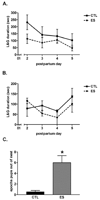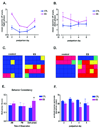Dysfunctional nurturing behavior in rat dams with limited access to nesting material: a clinically relevant model for early-life stress - PubMed (original) (raw)
Dysfunctional nurturing behavior in rat dams with limited access to nesting material: a clinically relevant model for early-life stress
A S Ivy et al. Neuroscience. 2008.
Abstract
Background: Early-life emotional stress may be associated with affective and cognitive disorders later in life, yet satisfactory animal models for studying the underlying mechanisms are limited. Because maternal presence and behavior critically influence molecular and behavioral stress responses in offspring, we sought to create a model of dysfunctional, fragmented maternal nurturing behavior that would, in turn, provoke chronic early-life stress in the offspring.
Methods: Sprague-Dawley rat dams' nursing and nurturing behaviors were altered by limiting their ability to create satisfactory nests during postpartum days 2-9. Maternal behavior was observed throughout the diurnal cycle, and the frequency and duration of nurturing behaviors were scored. In addition, potential stress and anxiety of the dams were assessed using behavioral, molecular and hormonal measures.
Results: Both the quantity and the quality of dams' care of their pups were profoundly influenced by restriction of nesting materials in their cages: licking/grooming activities decreased and the frequency of leaving the pups increased, resulting in fragmented interactions between the dams and pups. The abnormal activity patterns of the dams were accompanied by increased anxiety-like behavior in the open field, but not in the elevated plus maze tests. Additionally, dams' plasma corticosterone levels and adrenal weights were augmented, suggesting chronic stress of these dams. By the end of the limited-nesting, stress-inducing period, hypothalamic corticotropin releasing hormone (CRH) mRNA expression was reduced in the limited-nesting dams, while arginine-vasopressin (AVP) mRNA levels were not significantly affected.
Conclusion: Limiting dams' ability to construct a nest for their pups leads to an abnormal repertoire of nurturing behaviors, possibly as a result of chronic stress and mild anxiety of the dams. Because the fragmented and aberrant maternal behavior provoked chronic stress in the pups, the limited-nesting paradigm provides a useful tool for studying the mechanisms and consequences of such early-life stress experience in the offspring.
Figures
Fig. 1
Abnormal patterns of maternal nurturing behaviors of dams in cages with restricted nesting material (early-stress or ES). (A) Duration of ES dams’ licking and grooming (L&G) the pups was markedly decreased during dark-phase observation periods on postpartum days 2–5 (n = 7 dams per group, two-way ANOVA, effects of cage environment, F = 4.67, p < 0.05; + indicates the results of student’s _t_-test comparison of control and ES duration on P2). _(B)_ During the light phase, there were no significant differences in L&G duration (two-way ANOVA, F = 1.686, p > 0.05). (C) Pups in restricted nesting cages were significantly more likely to be displaced from the nest (p < 0.05; student’s _t_-test). *denotes significant difference from the controls (p < 0.05).
Fig. 2
Maternal nurturing behaviors of dams maintained in cages with restricted nesting material (ES) were inconsistent and fragmented. (A,B) Mean number of epochs during which ES dams were found away from the pups was significantly higher during postpartum days 2–5, during both the light-phase (A; two-way ANOVA, effect of cage environment, F = 47.19, p < 0.001; effect of postnatal day, F = 14.98, p = 0.001) and the dark-phase (B; two-way ANOVA, effect of cage environment, F = 5.16, p < 0.05) observation periods (n = 7 per group). (C,D) Representative examples of maternal caring activities from one control and one ES dam, during the light-phase (C) and dark-phase (D) observations, performed on postpartum day 5. Each individual color depicts the predominant behavior during the epoch / square. Blue: nursing; red: away from pups (off pups or out of the nest); yellow: licking and grooming pups; pink: dam eating and drinking, away from pups; green: dam licking and grooming self, away from pups. This graphic representation illustrates the fact that in control dams, each behavior typically lasted for several consecutive 3 minute epochs, whereas ES dams tended to switch behaviors frequently and unpredictably. (E) The behavior of ES dams (n = 7 per group) was less consistent, with frequent switching from one type of activity to another, during the dark, high activity portion of the diurnal cycle. This erratic behavior is reflected by a higher behavior score, which denotes increased numbers of initiating a new behavior during consecutive observation epochs (see the Results for detailed description of this score). (F) Mean duration of arched-back nursing episodes was influenced by the ES cage environment throughout the light-phase of the first 4 days in this environment (two-way ANOVA, effect of cage environment, F = 5.67, p < 0.05). *p < 0.05; students _t_-test.
Fig. 3
Dams rearing pups in restricted nesting material (ES) cages demonstrated increased anxiety in some but not other tests (n = 5 dams per group). In the open field task (A), percent time ES dams spent in the center of an open field chamber was significantly decreased (p < 0.05, _t_-test), without apparent alterations in freezing, licking and grooming behaviors (B). (C,D) Activities in the elevated plus maze were similar among control and ES dams; there were no differences in time spent on open vs. closed arms, nor in the number of arm entries., *p < 0.05; students _t_-test.
Fig. 4
Physiological and molecular parameters of chronic stress were apparent in dams that reared their offspring in restricted nesting material (ES) cages. (A) Mean adrenal gland weight per body weight was higher than in controls (p < 0.05), and body weight was not significantly altered (see text). (B) Basal AM plasma corticosterone levels were significantly elevated in ES dams compared with controls (n = 4 dams / group; p < 0.05). (C,D) Corticotropin-releasing hormone (CRH) expression in the hypothalamic paraventricular nucleus PVN was reduced on postpartum day 9, following a week of the ES cage environment (p < 0.05). (E,F) However, there were no apparent changes in the expression of arginine-vasopressin (AVP). *p < 0.05; students _t_-test.
Similar articles
- A novel mouse model for acute and long-lasting consequences of early life stress.
Rice CJ, Sandman CA, Lenjavi MR, Baram TZ. Rice CJ, et al. Endocrinology. 2008 Oct;149(10):4892-900. doi: 10.1210/en.2008-0633. Epub 2008 Jun 19. Endocrinology. 2008. PMID: 18566122 Free PMC article. - Prenatal stress increases HPA axis activity and impairs maternal care in lactating female offspring: implications for postpartum mood disorder.
Bosch OJ, Müsch W, Bredewold R, Slattery DA, Neumann ID. Bosch OJ, et al. Psychoneuroendocrinology. 2007 Apr;32(3):267-78. doi: 10.1016/j.psyneuen.2006.12.012. Epub 2007 Mar 2. Psychoneuroendocrinology. 2007. PMID: 17337328 - Chronic leptin administration in developing rats reduces stress responsiveness partly through changes in maternal behavior.
Oates M, Woodside B, Walker CD. Oates M, et al. Horm Behav. 2000 Jun;37(4):366-76. doi: 10.1006/hbeh.2000.1578. Horm Behav. 2000. PMID: 10860680 - Stress, sex, and addiction: potential roles of corticotropin-releasing factor, oxytocin, and arginine-vasopressin.
Bisagno V, Cadet JL. Bisagno V, et al. Behav Pharmacol. 2014 Sep;25(5-6):445-57. doi: 10.1097/FBP.0000000000000049. Behav Pharmacol. 2014. PMID: 24949572 Free PMC article. Review. - Early life experience shapes the functional organization of stress-responsive visceral circuits.
Rinaman L, Banihashemi L, Koehnle TJ. Rinaman L, et al. Physiol Behav. 2011 Sep 26;104(4):632-40. doi: 10.1016/j.physbeh.2011.04.008. Epub 2011 Apr 13. Physiol Behav. 2011. PMID: 21497616 Free PMC article. Review.
Cited by
- The impact of maternal neglect on genetic hyperactivity.
Majdak P, Grogan EL, Gogola JV, Sorokina A, Tse S, Rhodes JS. Majdak P, et al. Behav Brain Res. 2016 Oct 15;313:282-292. doi: 10.1016/j.bbr.2016.07.033. Epub 2016 Jul 19. Behav Brain Res. 2016. PMID: 27449202 Free PMC article. - Effects of developmental manganese, stress, and the combination of both on monoamines, growth, and corticosterone.
Vorhees CV, Graham DL, Amos-Kroohs RM, Braun AA, Grace CE, Schaefer TL, Skelton MR, Erikson KM, Aschner M, Williams MT. Vorhees CV, et al. Toxicol Rep. 2014;1:1046-1061. doi: 10.1016/j.toxrep.2014.10.004. Toxicol Rep. 2014. PMID: 25574457 Free PMC article. - Perinatal Depression and the Role of Synaptic Plasticity in Its Pathogenesis and Treatment.
Shenoy S, Ibrahim S. Shenoy S, et al. Behav Sci (Basel). 2023 Nov 17;13(11):942. doi: 10.3390/bs13110942. Behav Sci (Basel). 2023. PMID: 37998688 Free PMC article. Review. - The neurobiology of safety and threat learning in infancy.
Debiec J, Sullivan RM. Debiec J, et al. Neurobiol Learn Mem. 2017 Sep;143:49-58. doi: 10.1016/j.nlm.2016.10.015. Epub 2016 Nov 4. Neurobiol Learn Mem. 2017. PMID: 27826033 Free PMC article. Review. - Peripheral clock gene oscillations are perturbed in neonatal and adult rat offspring raised under adverse limited bedding conditions.
Walker CD, Delorme TC, Kiessling S, Long H, Cermakian N. Walker CD, et al. Sci Rep. 2023 Dec 21;13(1):22886. doi: 10.1038/s41598-023-47968-y. Sci Rep. 2023. PMID: 38129480 Free PMC article.
References
- Avishai-Eliner S, Eghbal-Ahmadi M, Tabachnik E, Brunson KL, Baram TZ. Down-regulation of hypothalamic corticotropin-releasing hormone messenger ribonucleic acid (mRNA) precedes early-life experience-induced changes in hippocampal glucocorticoid receptor mRNA. Endocrinol. 2001a;142:89–97. - PMC - PubMed
- Bhatnagar S, Dallman MF. Neuroanatomical basis for facilitation of hypothalamic-pituitary-adrenal responses to a novel stressor after chronic stress. Neurosci. 1998;84:1025–1039. - PubMed
Publication types
MeSH terms
Substances
Grants and funding
- R01 MH073136/MH/NIMH NIH HHS/United States
- MH73136/MH/NIMH NIH HHS/United States
- F31 MH087467/MH/NIMH NIH HHS/United States
- NIH NS28912/NS/NINDS NIH HHS/United States
- R01 NS028912/NS/NINDS NIH HHS/United States
- R01 NS039307/NS/NINDS NIH HHS/United States
LinkOut - more resources
Full Text Sources
Other Literature Sources
Medical
Miscellaneous



